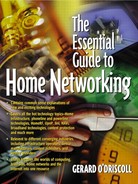IEEE 802.11 STANDARD
The development of any new technology is part theory and part practice. A key issue in telecommunications is the adoption of technical standards that govern the interoperability of equipment to provide a stable environment for deployment of products and services. This does not mean that all vendor equipment will work in the exact same way. A standard sets a norm or performance expectation on the function of the technology—not its implementation. The standard that governs the wireless LAN industry is the 802.11 family of standards that are part of the group that governs Ethernet data communications. This standard is evolving and adapting to meet the needs of industry as new technology is developed to allow new product design. IEEE 802.11 is comprised of two layers—physical and MAC layers.
802.11 Physical Layer
Like the IEEE 802.3 Ethernet and 802.5 token ring standards, the IEEE 802.11 specification addresses both the physical (PHY) and media access control (MAC) layers. At the PHY layer, IEEE 802.11 defines three physical characteristics for wireless local area networks: diffused infrared, direct sequence spread-spectrum (DSSS), and frequency-hopping spread-spectrum (FHSS).
While the infrared PHY operates at the baseband, the other two radio-based PHYs operate at the 2.4 GHz band. This latter frequency band is part of what is known as the ISM band, a global band primarily set aside for industrial, scientific, and medical use, but usable for operating wireless devices without the need for end-user licenses. For wireless devices to be interoperable, they have to conform to the same PHY standard. All three PHYs specify support for 1 Mbps and 2 Mbps data rates.
802.11 Media Access Control Layer
The 802.11 MAC layer, supported by an underlying PHY layer, is concerned primarily with rules for accessing the wireless medium. Some of the primary services provided by the MAC layer are as follows:
Data transfer— Wireless clients use a Collision Sense Multiple Access with Collision Avoidance (CSMA/CA) algorithm as the media access scheme.
Association— This service enables the establishment of wireless links between wireless clients.
Authentication— Authentication is the process of proving a client identity.
Privacy— By default, data is transferred "in the clear"; any 802.11-compliant device can potentially eavesdrop similar to PHY 802.11 traffic that is within range. Encryption techniques are employed to overcome this problem.
Power management— IEEE 802.11 defines two power modes, an active mode, where a wireless client is powered to transmit and receive, and a power save mode, where a client is not able to transmit or receive, but consumes less power. Actual power consumption is not defined and depends on the implementation.
Many of the wireless home networking technologies covered in the remaining part of this chapter are based on this family of standards.
In addition to promoting and developing 802.11, the IEEE organization has launched a new working group to develop standards for wireless personal area networks. A wireless personal area network, or WPAN, is best described as a low-cost networking scheme that enables computing devices such as PCs, laptop computers, printers, and personal digital assistants (PDAs) to wirelessly communicate with each other over short distances. It has a range of 10 meters and is capable of transmitting data around your home at speeds of 1 Mbps and above.
